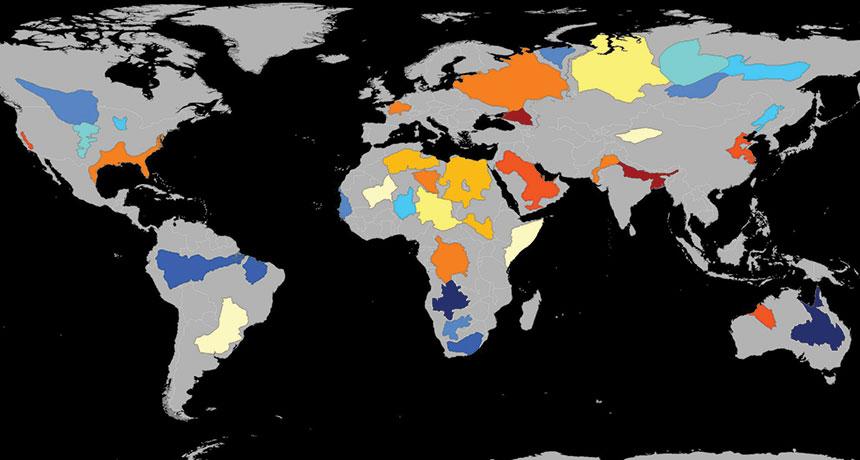Many of Earth’s groundwater basins are drying out
The majority of the world’s largest aquifers are quickly being drained

Of Earth’s 37 largest aquifers, 21 are shrinking, satellite data show. Here, redder regions represent overstressed aquifers. Those buried reservoirs lose more water each year than they gain.
UC Irvine/NASA
Around the world, large reservoirs of fresh water lie hidden underground. These groundwater basins are like banks. Water can be deposited, stored or withdrawn.
Now, changes in climate and human water usage are emptying those reservoirs, a new study finds. And it’s happening at an alarming rate. Of Earth’s 37 largest groundwater basins, 21 lose more water each year than they gain. Details appear in a paper to be published in Water Resources Research.
The conclusion is troubling. That’s according to study coauthor Sasha Richey. She is a hydrologist at Washington State University in Pullman. (Hydrology is the study of Earth’s water.) Groundwater quenches the thirst of about 2 billion people. It also irrigates crops.
“People need to think about groundwater as an important resource,” Richey says. “We’re not managing that resource adequately, or even at all, in most of the world.”
People extract groundwater by drilling into underground reservoirs called aquifers. Aquifers are refilled when water seeps down through the soil.
Scientists can monitor groundwater using wells. Water levels drop as an aquifer is drained. This method fails to provide a global picture of changes in water levels, though.
Richey and colleagues instead used data collected by the GRACE mission. These twin satellites measure small changes in Earth’s gravity. Variations in the density of Earth’s surface cause those small variations in gravity. (Density is a measure of how much mass is contained in a given volume.)
The emptying and refilling of groundwater basins is one way that the density of Earth’s surface changes. The GRACE satellites pass over these buried reservoirs regularly. As they do, the satellites “weigh” the mass of the water stored inside.
The researchers examined gravity changes over Earth’s largest aquifers from 2003 through 2013. Eight of the studied aquifers lost significant volumes of water over that decade. The researchers classified these aquifers as “overstressed.” That means almost no water naturally trickled in to replace water being pumped out. The regions of greatest concern were in the Middle East, northern Africa and northwestern India and Pakistan.
The most dried-up aquifers were in areas near large cities, in heavily agricultural areas or in arid climates. All three characteristics probably contributed to the extreme stress affecting the basins below central California, Richey says. California has both people and farms. It’s also in a multi-year drought. As a result, the state’s pumping of groundwater recently has skyrocketed.
The GRACE mission provides valuable information about how global groundwater has changed. It can’t measure exactly how much water is left in the aquifers, however, says Gordon Grant. He is a hydrologist with the U.S. Forest Service in Corvallis, Ore. Still, the new work allows scientists to “better understand, like an accountant would, withdrawals and deposits of groundwater around the world.”
Power Words
(for more about Power Words, click here)
accountant A person whose job it is to keep or inspect financial records.
agriculture The growth of plants, animals or fungi for human needs, including food, fuel, chemicals and medicine.
aquifer Rock that can contain or transmit groundwater.
arid A description of dry areas of the world, where the climate brings too little rainfall or other precipitation to support much plant growth.
climate The weather conditions prevailing in an area in general or over a long period.
climate change Long-term, significant change in the climate of Earth. It can happen naturally or in response to human activities, including the burning of fossil fuels and clearing of forests.
density A measure of the consistency of an object, found by dividing the mass by the volume.
drought An extended period of abnormally low rainfall; a shortage of water resulting from this.
gravity The force that attracts anything with mass, or bulk, toward any other thing with mass. The more mass that something has, the greater its gravity.
groundwater Water that is held underground in the soil or in pores and crevices in rock.
hydrology The scientific study of Earth’s water, especially in relation to land. Experts in this field are known as hydrologists.
irrigation The supply of water to land or crops to help growth.
mass A number that shows how much an object resists speeding up and slowing down — basically a measure of how much matter that object is made from. For objects on Earth, we know the mass as “weight.”
reservoir A large store of something. Lakes are reservoirs that hold water. People who study infections refer to the environment in which germs can survive safely (such as the bodies of birds or pigs) as living reservoirs.
satellite A moon orbiting a planet or a vehicle or other manufactured object that orbits some celestial body in space.
stress (in biology) A factor, such as unusual temperatures, moisture or pollution, that affects the health of a species or ecosystem. (in physics) Pressure or tension exerted on a material object.







